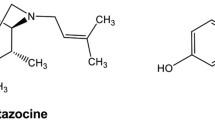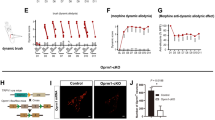Abstract
Opioid receptor like 1 (ORL1) receptor activation displayed an anti-nociceptive effect at spinal level for acute and neuropathic pain. SCH221510, an orally active non-peptide ORL1 agonist, was reported to be effective in treating neuropathic pain. The present study used ORL1 antagonist and siRNA to investigate that ORL1 activation mediates intrathecal SCH221510 analgesia in neuropathic pain induced by chronic constrictive injury (CCI) to rat sciatic nerve. Paw withdrawal latency and 50% mechanical threshold were measured for thermal and mechanical hypersensitivity in rats. CCI significantly decreased paw withdrawal latency and mechanical threshold. SCH221510 (3, 10, 30 μg) or ORL1 antagonist ([Nphe1]nociceptin(1-13)NH2, 10 μg) was intrathecally injected to test the behavioral effects on neuropathic pain. Intrathecal siRNA was started on 1 day before CCI surgery and maintained for 7 days. L4-L5 spinal cord ORL1 mRNA and protein were measured by real-time PCR and Western blot. The effect of intrathecal siRNA on SCH2210510 was tested in CCI rats on day 7. Intrathecal SCH221510 dose-dependently reduced thermal and mechanical hypersensitivity induced by CCI. [Nphe1]nociceptin(1-13)NH2 blocked SCH221510 analgesia in CCI rats. Intrathecal siRNA blocked ORL1 mRNA and protein increase induced by CCI. Intrathecal ORL1 siRNA did not change thermal and mechanical hypersensitivity induced by nerve injury. Intrathecal siRNA blocked SCH221510 analgesia in neuropathic pain at spinal level. Conclusively, ORL1 activation mediates SCH221510 analgesia in neuropathic pain at spinal level. The results warrant a potential clinically applicable drug in treating neuropathic pain.




Similar content being viewed by others
Abbreviations
- ORL1 :
-
opioid receptor like 1
- CCI:
-
chronic constrictive injury
- N/OFQ:
-
nociceptin/orphanin FQ
- PWL:
-
paw withdrawal latency
- PB:
-
phosphate buffer
References
Baker MD, Chen YC, Shah SU, Okuse K (2011) In vitro and intrathecal siRNA mediated K(V)1.1 knock-down in primary sensory neurons. Mol Cell Neurosci 48:258–265
Bennett GJ, Xie YK (1988) A peripheral mononeuropathy in rat that produces disorders of pain sensation like those seen in man. Pain 33:87–107
Bertorelli R, Bastia E, Citterio F, Corradini L, Forlani A, Ongini E (2002) Lack of the nociceptin receptor does not affect acute or chronic nociception in mice. Peptides 23:1589–1596
Briscini L, Corradini L, Ongini E, Bertorelli R (2002) Up-regulation of ORL-1 receptors in spinal tissue of allodynic rats after sciatic nerve injury. Eur J Pharmacol 447:59–65
Chen Y, Sommer C (2006) Nociceptin and its receptor in rat dorsal root ganglion neurons in neuropathic and inflammatory pain models: implications on pain processing. J Peripher Nerv Syst 11:232–240
Chen Y, Sommer C (2007) Activation of the nociceptin opioid system in rat sensory neurons produces antinociceptive effects in inflammatory pain: involvement of inflammatory mediators. J Neurosci Res 85:1478–1488
Cohen SP, Mao J (2014) Neuropathic pain: mechanisms and their clinical implications. BMJ 348:f7656
Courteix C, Coudore-Civiale MA, Privat AM, Pelissier T, Eschalier A, Fialip J (2004) Evidence for an exclusive antinociceptive effect of nociceptin/orphanin FQ, an endogenous ligand for the ORL1 receptor, in two animal models of neuropathic pain. Pain 110:236–245
Cremeans CM, Gruley E, Kyle DJ, Ko MC (2012) Roles of mu-opioid receptors and nociceptin/orphanin FQ peptide receptors in buprenorphine-induced physiological responses in primates. J Pharmacol Exp Ther 343:72–81
Decosterd I, Woolf CJ (2000) Spared nerve injury: an animal model of persistent peripheral neuropathic pain. Pain 87:149–158
deGroot JF, Coggeshall RE, Carlton SM (1997) The reorganization of mu opioid receptors in the rat dorsal horn following peripheral axotomy. Neurosci Lett 233:113–116
Dowell D, Haegerich TM, Chou R (2016) CDC guideline for prescribing opioids for chronic pain - United States, 2016. MMWR Recomm Rep 65:1–49
Faber ES, Chambers JP, Evans RH, Henderson G (1996) Depression of glutamatergic transmission by nociceptin in the neonatal rat hemisected spinal cord preparation in vitro. Br J Pharmacol 119:189–190
Finnerup NB, Attal N, Haroutounian S, McNicol E, Baron R, Dworkin RH, Gilron I, Haanpaa M, Hansson P, Jensen TS, Kamerman PR, Lund K, Moore A, Raja SN, Rice AS, Rowbotham M, Sena E, Siddall P, Smith BH, Wallace M (2015) Pharmacotherapy for neuropathic pain in adults: a systematic review and meta-analysis. Lancet Neurol 14:162–173
Hayashi S, Nakata E, Morita A, Mizuno K, Yamamura K, Kato A, Ohashi K (2010) Discovery of {1-[4-(2-{hexahydropyrrolo[3,4-c]pyrrol-2(1H)-yl}-1H-benzimidazol-1-yl)piperidin-1-yl]cyclooctyl}methanol, systemically potent novel non-peptide agonist of nociceptin/orphanin FQ receptor as analgesic for the treatment of neuropathic pain: design, synthesis, and structure-activity relationships. Bioorg Med Chem 18:7675–7699
Houtani T, Nishi M, Takeshima H, Sato K, Sakuma S, Kakimoto S, Ueyama T, Noda T, Sugimoto T (2000) Distribution of nociceptin/orphanin FQ precursor protein and receptor in brain and spinal cord: a study using in situ hybridization and X-gal histochemistry in receptor-deficient mice. J Comp Neurol 424:489–508
Ikeda K, Kobayashi K, Kobayashi T, Ichikawa T, Kumanishi T, Kishida H, Yano R, Manabe T (1997) Functional coupling of the nociceptin/orphanin FQ receptor with the G-protein-activated K+ (GIRK) channel. Brain Res Mol Brain Res 45:117–126
Ko MC, Naughton NN (2009) Antinociceptive effects of nociceptin/orphanin FQ administered intrathecally in monkeys. J Pain 10:509–516
Ma F, Xie H, Dong ZQ, Wang YQ, Wu GC (2005) Expression of ORL1 mRNA in some brain nuclei in neuropathic pain rats. Brain Res 1043:214–217
Mogil JS, Grisel JE, Zhangs G, Belknap JK, Grandy DK (1996) Functional antagonism of mu-, delta- and kappa-opioid antinociception by orphanin FQ. Neurosci Lett 214:131–134
Mogil JS, Pasternak GW (2001) The molecular and behavioral pharmacology of the orphanin FQ/nociceptin peptide and receptor family. Pharmacol Rev 53:381–415
Nishi M, Houtani T, Noda Y, Mamiya T, Sato K, Doi T, Kuno J, Takeshima H, Nukada T, Nabeshima T, Yamashita T, Noda T, Sugimoto T (1997) Unrestrained nociceptive response and disregulation of hearing ability in mice lacking the nociceptin/orphaninFQ receptor. EMBO J 16:1858–1864
Obara I, Przewlocki R, Przewlocka B (2005) Spinal and local peripheral antiallodynic activity of Ro64-6198 in neuropathic pain in the rat. Pain 116:17–25
Pettersson LM, Sundler F, Danielsen N (2002) Expression of orphanin FQ/nociceptin and its receptor in rat peripheral ganglia and spinal cord. Brain Res 945:266–275
Rizzi A, Sukhtankar DD, Ding H, Hayashida K, Ruzza C, Guerrini R, Calo G, Ko MC (2015) Spinal antinociceptive effects of the novel NOP receptor agonist PWT2-nociceptin/orphanin FQ in mice and monkeys. Br J Pharmacol 172:3661–3670
Small KM, Nag S, Mokha SS (2013) Activation of membrane estrogen receptors attenuates opioid receptor-like1 receptor-mediated antinociception via an ERK-dependent non-genomic mechanism. Neuroscience 255:177–190
Sobczak M, Mokrowiecka A, Cygankiewicz AI, Zakrzewski PK, Salaga M, Storr M, Kordek R, Malecka-Panas E, Krajewska WM, Fichna J (2014) Anti-inflammatory and antinociceptive action of an orally available nociceptin receptor agonist SCH 221510 in a mouse model of inflammatory bowel diseases. J Pharmacol Exp Ther 348:401–409
Standifer KM, Rossi GC, Pasternak GW (1996) Differential blockade of opioid analgesia by antisense oligodeoxynucleotides directed against various G protein alpha subunits. Mol Pharmacol 50:293–298
Stanfa LC, Chapman V, Kerr N, Dickenson AH (1996) Inhibitory action of nociceptin on spinal dorsal horn neurones of the rat, in vivo. Br J Pharmacol 118:1875–1877
Sukhtankar DD, Zaveri NT, Husbands SM, Ko MC (2013) Effects of spinally administered bifunctional nociceptin/orphanin FQ peptide receptor/mu-opioid receptor ligands in mouse models of neuropathic and inflammatory pain. J Pharmacol Exp Ther 346:11–22
Tian JH, Xu W, Fang Y, Mogil JS, Grisel JE, Grandy DK, Han JS (1997) Bidirectional modulatory effect of orphanin FQ on morphine-induced analgesia: antagonism in brain and potentiation in spinal cord of the rat. Br J Pharmacol 120:676–680
Truini A (2017) A review of neuropathic pain: from diagnostic tests to mechanisms. Pain Ther 6:5–9
Varty GB, Lu SX, Morgan CA, Cohen-Williams ME, Hodgson RA, Smith-Torhan A, Zhang H, Fawzi AB, Graziano MP, Ho GD, Matasi J, Tulshian D, Coffin VL, Carey GJ (2008) The anxiolytic-like effects of the novel, orally active nociceptin opioid receptor agonist 8-[bis(2-methylphenyl)methyl]-3-phenyl-8-azabicyclo[3.2.1]octan-3-ol (SCH 221510). J Pharmacol Exp Ther 326:672–682
Wang JL, Zhu CB, Cao XD, Wu GC (1999) Distinct effect of intracerebroventricular and intrathecal injections of nociceptin/orphanin FQ in the rat formalin test. Regul Pept 79:159–163
Xu M, Aita M, Chavkin C (2008) Partial infraorbital nerve ligation as a model of trigeminal nerve injury in the mouse: behavioral, neural, and glial reactions. J Pain 9:1036–1048
Zajac JM, Lombard MC, Peschanski M, Besson JM, Roques BP (1989) Autoradiographic study of mu and delta opioid binding sites and neutral endopeptidase-24.11 in rat after dorsal root rhizotomy. Brain Res 477:400–403
Zimmermann M (1983) Ethical guidelines for investigations of experimental pain in conscious animals. Pain 16:109–110
Acknowledgements
Thanks Fei Liu for editing the manuscript.
Availability of Data and Materials
The authors will provide data upon request.
Funding
The study was funded by the Xinxiang Central Hospital Startup fund.
Author information
Authors and Affiliations
Contributions
QW designed the experiment, carried out the study, and drafted the manuscript. LL carried out the experiments.
Corresponding author
Ethics declarations
Ethics Approval
The experiment was approved by the Animals Care and Use Committee of Luoyang Medical College.
Consent for Publication
The authors have consent to publish the study.
Competing Interest
The authors declare that they have no competing interests.
Rights and permissions
About this article
Cite this article
Wu, Q., Liu, L. ORL1 Activation Mediates a Novel ORL1 Receptor Agonist SCH221510 Analgesia in Neuropathic Pain in Rats. J Mol Neurosci 66, 10–16 (2018). https://doi.org/10.1007/s12031-018-1140-0
Received:
Accepted:
Published:
Issue Date:
DOI: https://doi.org/10.1007/s12031-018-1140-0




